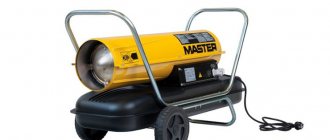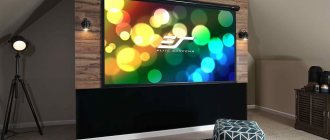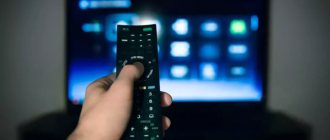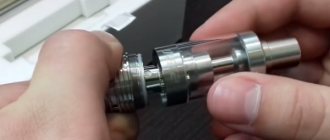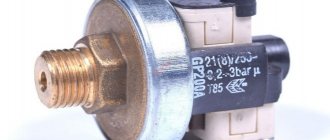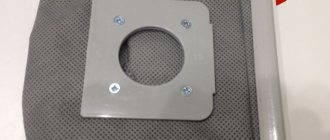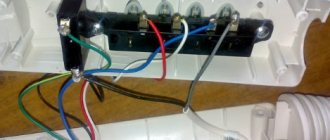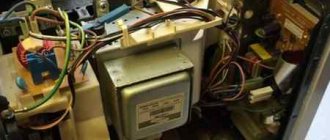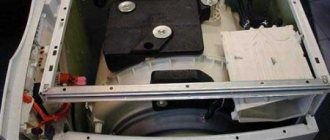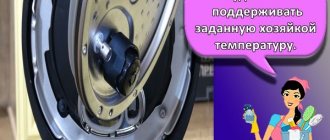Home / Lighting devices / Lanterns
Back
Reading time: 7 min
0
213
Making a projector with your own hands is much easier than it seems at first glance. If desired, anyone, even a teenager, can assemble the simplest version of the design. This does not require expensive components; you can find the necessary parts cheaply or even for free, it all depends on the chosen project.
This is what a simple shoebox projector looks like.
- Calculation of parameters and implementation features
- How to make a home theater projector using a phone
- Laptop based projector
- Using your device to view slideshows
- Ways to improve picture quality
How the projector works
A projector, like all kinds of sliders and filmoscopes, is based on the laws of optics: when the image carrier interacts with light streams, the rays are refracted, the image is enlarged, and transmitted to the screen.
Methods for making a projector with your own hands can be different, based on the simplest and most basic - passing light through transparent media (magnifying glass, lenses), such devices are called slide projectors. Epiprojectors are based on reflection from opaque objects. Digital multimedia DLP and LCD are of the highest quality, with extremely clear images and accurate color rendition, since they do not use the traditional principle of a magnifying glass. In the first, the flow is reflected from a special chip and created by a logical matrix; in the second, a transparent LCD panel is used, providing a bright, vibrant color range.
It is extremely difficult to assemble a digital multimedia structure on your own - you will need to synchronize the work of mechanics, optics, and digital parts. But it is quite possible to make a projector for a phone (slide projector) or a more complex installation with digital equipment with minimal knowledge of electrical engineering (in the first case it will not be required at all).
DIY making
A good projector will cost you a considerable amount, so it’s worth thinking about how to make one for your phone yourself.
This projector is easily assembled from scrap materials. Here is a list of what you need:
- Hot glue gun;
- Elongated rectangular box;
- Magnifying glass;
- Black marker or paint;
- Stationery knife.
If you have collected everything you need, then you can start making a projector from your smartphone with your own hands.
Paint the inside of the box and lid black to prevent light from reflecting off the walls and interfering with the operation of the device. Wait for the paint to dry and begin cutting out the hole for the lens.
Remember that the magnifying glass is the key element of the projector. The quality of the picture directly depends on it. Never buy cheap glasses with plastic lenses. Glass lenses from 10x magnifiers are ideal. If you have a Soviet magnifying glass lying around at home, use it. If you don’t know which box to use, take one from under your shoes; it has the right size. Attach a magnifying glass to the end of the box and circle it with a marker. Use a utility knife to cut a hole along the outline and install a magnifying glass there.
There are only two options for installing a magnifying glass: install the entire magnifying glass or remove the lens from it and install only that. Choose the option that is convenient for you and install the glass.
Plug in the gun and wait until the glue in it melts. Be careful when working with a glue gun. The glue in it is heated to 130 °C and causes deep burns if it comes into contact with the skin. Place the lens on the hole and apply a little hot glue on different sides. Align the lens with the body and hold until the glue hardens. Take a gun and seal the remaining cracks with glue. Once cured, carefully cut off excess glue from the lens.
Place your phone in the box. You need to place it sideways, with the screen facing the lens. Set the brightness on your phone to maximum and play a video. Turn off the lights in the room and point the lens of the box at the wall. A fuzzy image will appear on the wall. By bringing your phone closer or further away from the lens, get a clear picture to appear on the wall. As you can see, making a projector at home is very simple. Now you can stock up on cookies and enjoy watching your favorite movie on the big screen.
Overhead projector with smartphone
A smartphone and similar gadgets have a small screen. The task is to enlarge its image and broadcast it onto a flat surface. For this purpose, illumination and optics are used: a large magnifying glass, a magnifying glass. In projectors, such elements are called Fresnel lenses. With minor additions, this principle is used in factory products of this type.
What you will need:
- large magnifying glass. The size must correspond to the smartphone screen located at some distance so that the picture is not cropped;
- completely darkened case: cardboard, wooden (plywood) or plastic box. You can make anything out of a box, for example, a shoe box. It’s easy to create an element with internal fasteners (fixing partitions) with your own hands: any material that can be cut and fastened will do;
- if cardboard is used, then the homemade product is assembled using tape, glue, a stationery knife, pencil, ruler, and compass. For wood, you may need a jigsaw, for plastic, it is also a soldering iron or a burning device, the heated tip of which can be used to process the material.
Let's look at the simplest homemade projector from a phone with a cardboard body:
- Place a lens on the front wall of the box and trace it with a pencil. Cut a hole and secure the magnifying glass there with glue; tape can also be used. It is important that these materials do not fall into the gap, which will spoil the image.
- They place the smartphone inside and experimentally correlate the distance to its screen from the lens so that the picture is not cut off by it. At this point, holders - partitions - are glued.
- A hole is made at the back for the charging cable.
- They insert the phone into the seat; first you need to install an application that flips the image 180°, or deactivate auto-rotate and place the smartphone upside down.
- Viewing is organized in a well-shaded place.
Making a projector with your own hands using a phone
Modern gadgets often have a solid extension, through which you can get high-quality video broadcasting. You can watch any movies on the Internet, as well as self-made videos. Let's take a closer look at the stages of manufacturing such a device.
The simplest projector
To make a simple device, you will need a minimum of parts. However, you shouldn’t count on full image quality in this case, since most smartphones are not capable of transmitting images in sufficient brightness over long distances. However, this is a great alternative if you don't have a projector at all.
What you need for work
To construct a projector, you will need a cardboard or wooden box, as well as a smaller cardboard case in which you need to make a niche for a smartphone. To reduce light reflection from the walls of the box, you need to paint it black. Shoe polish or matte paint is ideal for this. You will also need a lens.
Preparing all elements
The sequence of operations is as follows.
- We arrange the box correctly. To do this, paint the inside of the body with a dark color.
- We place a smaller box in it so that the prepared niche into which the smartphone will be inserted is the size of the screen.
- We direct the open part to the free edge of the second box.
- We prepare a pendant or stand for the lens, place it on the table, and attach the magnifier to it.
- It can be attached to a cardboard box, having previously cut out a special niche for this.
- To prevent the magnifier from falling, it is secured with a glue gun.
Assembly of the structure
When all the parts are arranged, all that remains is to assemble them into a single whole. We insert the switched-on smartphone into the prepared niche and direct the image through the lens onto the canvas installed as a screen.
It is convenient to use such a film projector if you have a remote control that works via Wi-Fi, otherwise you will have to remove the phone from the box for each switch.
Holographic projector manufacturing process
Holographic projectors are able to accurately convey the image from any mobile gadget, provided that maximum brightness is turned on. You can find the parts in your workshop or spend a little money purchasing a few suitable items from the store.
List of materials and tools
To quickly create a 3D projector you will need:
- CD case;
- glue gun;
- painting or stationery knife;
- pliers;
- smartphone;
- special video with holographic graphics;
- corresponding drawing.
It is important to comply with all the dimensions specified in the drawing, otherwise it will be impossible to achieve clarity of the image.
Manufacturing parts for the projector
To create a truncated pyramid, we will use a drawing that will allow us to calculate the dimensions of each part.
Let's consider a step-by-step algorithm:
- Using the drawing, mark four identical sketches on the plastic from the disc case, and, using a utility knife, carefully cut them out.
- We glue all these parts together with a glue gun so that we get a truncated pyramid.
- When nicks appear on the ends of the patterns, they are processed with sandpaper.
- We install the smartphone on the top of the pyramid so that the display is located in the center.
- We put dark or matte cardboard on top (so that the animation is not mirrored).
Similarly, you can use the projector in a vertical position. But for this you will need to make stands that hold the smartphone and matte cardboard.
Adjusting the image on your smartphone
In order for the picture to be fully displayed on a matte surface, you need to make some screen adjustments. Be sure to set the brightness to the maximum level, adjust the color so that it is natural. In this situation, it is advisable to set the contrast mode to automatic and the background color to the “Standard” position.
Projector from tablet, laptop
When projecting a device from a laptop, tablet, or even from a small computer monitor (the PC unit itself will stand separately), the image quality will be better, since the screen is larger.
Let's consider a “humane” method in which there is no need to disconnect the matrix with the monitor from the laptop. The inhumane method is the same, but the gadget is disassembled, the specified assembly is pulled out and used as a display, in which case you will need an extension cable to the part with the keyboard (it is sold in electronics stores and on online sites).
You will need the same tools as in the previous case, but you need to take a larger cardboard box or box, for example, from large household appliances. Its front part should fit the size of the matrix, the length should be from 50 cm. The lens should be large. You can buy (Fresnel or regular lenses), remove from a device for reading full-page books or from special lamps that are used in restoration work, in medicine, in laboratories (an illuminated circle with a magnifying glass).
Assembly process step by step:
- For a magnifying glass, make a hole at the end of the box slightly smaller than the lens to securely fasten it.
- Fix the lens with tape, silicone glue, acrylic sealant, epoxy resin. The fit should be tight to prevent light from entering.
- A connector for the laptop screen is cut on the opposite wall. The edges of the cardboard should overlap it for the reason stated above.
- Open the laptop and place it upside down, so that the keyboard is on top of the box and the monitor is placed in the hole for it. Thus, the principle of optical reversal by the lens that we need is simultaneously implemented.
You can adapt the tablet in the same way as described.
Projector out of the box (DIY)
A projector is a good thing, but expensive, and it’s not needed often, so rarely does anyone have one at home. After my post, I scoured the Internet and found a way to make a projector from a phone/netbook/tablet and a simple box.
For a projector from a phone, we need: - a shoebox (preferably with a black interior, but you can also paint it), - a telephone, - a magnifying glass - a magnifying glass, - a pencil, - a knife/cutter, - dark adhesive tape / electrical tape, - a paper clip for fixing phone (how to make a stand can be seen in the source).
We draw a magnifying glass around the middle of one side and cut it out.
We insert a magnifying glass and carefully glue the joint so that there are no gaps and light does not enter there.
We place the phone, fix it at the required distance - the projector is focused by moving the phone in the box relative to the magnifying glass, move the phone starting from the back wall of the box until the image begins to come into focus. When light passes through the lens, it is reflected and the image coming out of the projector lens is upside down. It's not a problem - just figure out how to flip the image on your phone. Close the lid, turn off the light and enjoy the slides. Source Source Source
But the image from the phone is quite blurry, since the picture is small and the screen brightness is not high. To improve the result, you should use a laptop or tablet.
For this we will need: - a cardboard box - should be about half a meter on the long side, and the front part should be larger than the screen of your tablet or laptop. - tape, - pencil, - knife/cutter, - Fresnel lens made of hard plastic, for a tablet - a box or books the size of it and rubber bands.
It can be bought on ebay (keywords: Fresnel lens). The price is around 6-10 dollars. For this project, a Fresnel lens measuring 20x25 centimeters was used.
Ideally, the hole on the front panel should be a couple of centimeters smaller than the Fresnel lens. Use the lens as a template to draw a rectangle. Draw a second rectangle inside the first, stepping back a couple of centimeters.
It is not necessary to draw a rectangle drawn with a bank card. This hole will be used as an iris inside the projector to enhance the image if you decide to use a smartphone.
Use tape to secure the Fresnel lens to the front of the projector. The corrugated part of the lens should be directed towards the inside of the box. Once the lens is installed, the box can be folded.
We secure the tablet with rubber bands to the box/books and insert it into our “projector”.
When using a laptop, this design will be too small.
In this case, you can cut a hole on the side of the box and turn the laptop upside down. At the moment, this is the easiest and fastest way to assemble a projector. In addition, the laptop gives better results, because... its screen is the largest and brightest.
The image you project onto the screen is flipped horizontally and vertically. You can fix this by turning your tablet or laptop over. Note that the image will still be flipped horizontally, although the top-bottom orientation will be correct. This means that the numbers and words on the screen will be from right to left.
Since the Fresnel lens is flat, there is some optical distortion in the image. For example, the edges of the screen may be slightly blurred, but the center will be in focus. The brightness of the device should be set to maximum to obtain maximum luminous flux. If you can keep the room completely dark, the image will be clearer and brighter. An image with a diagonal of 120 centimeters is quite watchable when using a laptop and also when using an iPad. Of course, the closer you move the projector to the screen, the smaller the image will be, but it will be brighter and more in focus. Source
PySy: the images turn out to be quite small for transferring the picture to the wall, but if it is an image without a background and, again, without very small details, then moving the projector further away, we get a blurry, but large picture, which should be suitable for tracing the outline.
Professional projector made of LCD matrix and electronics
Let's make a reservation right away: a homemade LED projector is labor-intensive to assemble, the total cost of parts is approximately $1000, but it is cheaper than factory devices of this level. Spare parts are purchased from well-known Chinese trading platforms.
What you will need:
- LCD monitor (5.98 inches, 2560×1440) with HDMI card ($200). You can take these elements from used devices; any 2K LCD display will do. No backlight module required;
- laser-cut polymer body ($100). Or you can create it yourself with a plywood jigsaw. There are AutoCad drawings online; (https://cdn.instructables.com/ORIG/F4I/A5S0/IN0TKC4U/F4IA5S0IN0TKC4U.zip);
- 2 Fresnel lenses ($50 each): with focal lengths of 120 and 185 mm. The first (F120) is placed between the LED and the LCD matrix, the second (F185) - between it and the projection lens;
- F190 or 200 lens (up to $50);
- one of the following LEDs with a suitable driver (about $50): regular 150 or 128 W with heat sink;
- alternative - 100 W, not particularly bright, but suitable for a dark room;
- the best option, but more expensive (together with the driver $185) is SVT-140 “Luminus Devices”, such elements are used in medical endoscopes;
Next, assembly step by step.
Case design, checking the LCD matrix
The display must be purchased with an HDMI card. Also, for convenience, it is recommended to purchase an FPC extension cable (cable) and a connection board (connector). We check the matrix by pressing and holding the backlight connector. Next, we proceed to constructing the body.
The body is assembled according to the drawings. You will need the usual tools: knife, pencil, ruler, jigsaw, glue. Materials: textolite, plastic, wood. You can adapt an old computer unit, but then you will need tools for working with tin: wire cutters, a hacksaw, a screwdriver and drills for making holes for bolts.
Partitions and holders are made inside. Fresnel lenses are inserted into the seats, then the holder itself is inserted into the clamps of the LCD monitor. In this case, it is necessary to exclude any reflection of light from the partitions, otherwise the image quality will deteriorate. For this purpose, sandpaper the surfaces, making them matte.
Monitor mount
We will dwell on this part in more detail, since careless assembly of the element can ruin the final result. The display is small and has very thin bezels, making it difficult to prevent loss of light output. It is advisable to look at the drawings from the Internet - they take this nuance into account. If we approach this stage without proper care, we will get a picture with noticeable white stripes along the edges.
If you use a standard drawing, it provides for the presence of 3 parts of the holder: 2 for permanent fixation and 1 for temporary fixation. It is advisable not to touch the display while working: the prints will be enlarged in the final image. The problem is eliminated if you perform the assembly wearing medical gloves.
LED Installation
The LED is attached to a heat sink, which is purchased as a kit or separately, and you can also use computer radiators from the processor air cooling system. Next, we build a holder for this structure using the same drawings from the network. The diode is screwed with M3 screws to the radiator, the landing pad is lubricated with thermal paste. Then a condenser lens is installed in front of the light source, usually a mount is included in its kit.
Wiring, cooling
Our example uses a standard drawing that provides mounting locations for fans. We install them there, you can include a rotation speed regulator in the circuit (a 10 kOhm trimming resistor, soldered to one of the wires), there are also boards with it and a temperature sensor: by reducing the speed, the noise of the structure will decrease.
Connection rules:
- voltage from the 220 V home network is supplied to the power supply for the LED, coolers and HDMI chip via USB;
- The power supply produces direct current, it is connected to the diode and the impeller. Separate power supplies can be used. The unit with the USB connector will be connected to the HDMI chip;
- install 2 switches - for the LED, display, coolers - which will allow the device to cool for some time after turning off;
- The LED gets very hot, the matrix gets less hot, but it also gets hot, and the heat generated is intense; black spots may appear on the monitor due to overheating, and it will fail. Therefore, it is necessary to use several fans, at least 2 of different sizes, correctly placing them for blowing and blowing;
- the screen is placed next to the light source (gap 110–130 mm).
Checking the arrangement of elements
Check the wires according to the photos attached to the article. Then analyze how the LED is positioned - with the correct gap between it and the rear lens (F120), the light illuminates the entire active area of the screen. The grooved sides of the two lenses should be facing towards the monitor.
Other combinations of lenses are also used, but the one described is optimal for a 5-6-inch display. You can also take optics with a long focal length - F120/F220 with projection F230 - as the focal length decreases, the image increases. In our case, if we use the CBT-140 diode, the video projector will provide clarity at which you can see the pixels on the projection surface. And focusing will be superior to some factory units.
Recommendations
The distance between the optics is selected by trial and error, tips:
- between the display and the magnifying glass 15–20 mm;
- an excessively small gap can lead to overheating and failure of the LCD matrix;
- if the gap is too large, the picture will be blurry;
- between the rear optics (F120) and the light source the gap is 90% of the focal length of the lens. Move the magnifying glass +/- this amount to find the best ratio;
- between the projection magnifier and the front one (F185) the gap is approximately equal to the focal gap of the first (in this case 190 mm is suitable);
- Focus is adjusted by moving the projection lens closer/farther away. The image is clearer when the LED's emitting area is more focused. Also for this reason, you should not save on cheap such elements; it is better to choose SVT-140.
How to make a high resolution projector
Not everyone can make a high-quality projector with their own hands at home, as it requires certain skills. If you cannot separate the matrix from the light-distributing substrate, do not undertake this task.
You will need:
- 2 Fresnel lenses;
- A good magnifying glass lens;
- A section of sewer pipe of the same diameter as the lens;
- 2 guides with plain bearings;
- Long screw with nut;
- Fastenings for screw and guides;
- 100 watt LED;
- Processor radiator with a power dissipation of at least 100 watts;
- Computer fans 120 and 80 mm;
- Computer power supply 300 watts;
- Boost DC-DC converter 150 watts;
- Two-core cable with a total cross-section of 2 mm²;
- Cheap Chinese tablet or phone with OTG support;
- Tact button;
- Glue B-7000;
- Any thermal paste;
- Hot melt adhesive;
- 4 silicone or rubber feet;
- Sheet plastic that does not transmit light;
- A can of matte black paint;
- 2 furniture hinges;
- Plywood;
- Corners for fastening sheets of plywood;
- A screw from a valve, a wheel from a toy car, or something else that is suitable for the focus knob;
- Self-tapping screws.
The dimensions of the projector directly depend on the matrix you choose, so when reading the diagrams, be guided by the proportions. If they don't match a little, it's okay. The main thing is that everything works.
Deciphering the designations:
- LCD matrix.
- Fresnel lenses.
- Fresnel lens holders.
- Matrix holder.
- Guide fastenings.
- Screw fastening.
- Guides.
- Screw.
- Sliding bearings.
- Screw.
- Lens carriage.
- Lens holder.
- Lens.
- Focus knob.
- Phone motherboard.
- Display matrix cable.
- Air intakes.
- Loops.
- 120 mm fan.
- Cover border.
- Light-emitting diode.
- Radiator.
- 80 mm fan.
- Lens hole.
- USB phone connector.
- Motherboard power cable.
- Power supply and converter.
- Fan power cable.
- Ventilated compartment cover.
- LED power cables.
- Rubber feet.
- Motherboard power button.
To get started, visit a furniture, construction and radio store. There you will find everything you need. When you get home, check if you bought everything. Otherwise, you risk finding yourself in a situation where half the project is ready and then it turns out that some detail is missing. And according to the law of meanness, this will happen at a time when stores are closed.
Manufacturing of individual parts
Decide on the dimensions and cut out the component parts of the body from plywood. There are only 7 of them:
- Base;
- Top;
- Ventilated compartment cover;
- Front and back panels;
- 2 side walls.
Paint the inside of all the pieces matte red. Solder a plate with holes to the nut on which the carriage will be attached. Install one guide mount onto the base and secure it with self-tapping screws. Place the bearing on the guide and insert it into the installed mount. Then place the second fastener on the free end of the guide and screw it to the base. Repeat this operation with the second guide and screw. The screw is installed strictly along the longitudinal axis of the base, and the guides are installed at the same distance from it.
Cut a carriage out of plywood and secure it to the guides using staples and screws. Do not forget to tighten the nut, without it the carriage will not be able to move. Secure the bearings and nut in the center of the carriage, otherwise it will warp. Cut about 5 cm from the sewer pipe. Insert the lens removed from the magnifying glass into the section and secure it with hot glue. Glue the resulting lens to the carriage with hot glue.
Cut holders for Fresnel lenses from plywood. Make cuts in them in advance for laying the matrix cable and power wires. Place the lenses in the center of the holders and glue them. Cut the holder for the matrix out of plastic, glue it to plywood - not a good idea. The cutout in the holder should be slightly smaller than the matrix itself.
Unclip the cover from the phone, remove or disconnect the battery and unscrew all the bolts. Disconnect the display cable from the motherboard and remove it. Unscrew the screws holding the display and remove it from the phone body. If the display is glued with double-sided tape, carefully pry it around the perimeter with a credit card until it comes off. Using your fingernails, carefully separate the light-distributing substrate with LEDs from the matrix. Try not to damage the conductive tracks and cables going to the matrix.
Use a sharp utility knife or scalpel to cut off the separated backing. Coat the edges of the cutout with B-7000 glue and cover it with the matrix. Place a book on the resulting sandwich and wait until the glue dries. To prevent the cable from coming off, glue it to the holder. Fresnel lenses are glued to the holders in the same way.
Solder the wires to the LED and screw it to the radiator, after lubricating it with thermal paste. Insert the radiator with the LED into the cutout on the rear panel and secure it with the corners. Install an 80 mm fan on it and route the wires into the cutout. Make ventilation holes in the side walls and assemble air intakes from plywood. Install a 120 mm fan on the inside of the wall and air intakes on the outside.
The intake holes should face backwards so that the light coming out of them does not hit the screen. Unsolder the standard power button from the motherboard and solder the wires in its place. Also solder wires to the battery connection terminals. Using small screws, secure the board to the side wall. Cut all the necessary holes in the front panel and begin assembling the projector.
Assembly into a single whole
Using corners and self-tapping screws, connect the base to the front and rear panels. Attach the side walls to them. Place the holders with the matrix and lenses in place. The lens closest to the LED should be placed away from the matrix with an interval of two centimeters. This will protect it from unwanted heat. Install the remaining lens tightly.
Solder the clock button to the wires from the motherboard and insert it into the front panel. Fill the button from the inside of the case with hot glue, thereby securely fixing it. Connect the 12 volt line from the power supply to the input of the converter and set it to the LED voltage. Connect the LED power cable to the output of the converter. Connect the wires from the fans to twelve, and from the motherboard to the five-volt line. When connecting all wires, observe polarity. If you confuse the plus with the minus, your motherboard will burn out.
First startup and setup
Insert the cable from the matrix into the motherboard and cover the entire structure with a lid. Place the projector in a dark room, point it at the wall and turn it on. Install the focus knob onto the screw. Rotate it until a clear image appears on the wall. If all else fails, carefully move the holders with lenses and matrix back and forth. After a clear image appears, carefully fix the holders with hot glue. Attach the top to the case and fix the power supply with the converter on it. Replace the hinges and hang the lid on them. Glue the rubber feet to the base and place the finished projector in the place prepared for it.
As it turns out, you can make a projector with your own hands. Moreover, it is of high quality, not inferior to store-bought ones. And the materials spent on its production will cost you much less than a new projector. The only question is whether you have free time and skills. But it rarely happens that a person has no free time at all, and when there is time, skills will appear.
Wi-Fi controlled option
The picture below shows how to assemble an LED projector with your own hands at home and what you will need for this.
The body is created as described above. Let us illustrate further:
Projector from a slide device
If you have a used or unnecessary device for slides, you can use it for a projector. Moreover, in the future it will be possible to assemble it back. No manipulations with the optics are required - everything is already ready. The device displays pictures in A4 format, that is, it is advisable to choose a larger display, from a tablet or laptop.
Actions:
- We disconnect the matrix from the tablet and the board.
- We place the display on the glass, the gap is 4–6 mm.
- We install a small cooler on the side, you can glue it with double-sided tape.
- We connect the tablet to the network.
If you are using a laptop and decide to install the keyboard unit separately (this will make it convenient to operate), then you will need an extension cable. But you can also try the “humane” method: open the gadget and place the screen on the glass of the slidescope, and hang the part with the keyboard to the side or leave it in a horizontal position. But then you can control it without removing the gadget only with a mouse, however, this is quite enough for viewing videos and pictures.
Gobo projector
The principle of a gobo projector is simplistically similar to that of laser pointers. This device is often used to broadcast advertising logos, text and pictures.
Used:
- a regular LED lighting spotlight, a wire with a switch is soldered to it;
- Instead of the protective glass of the light bulb, there is a lens. For experiments, as well as for the lens, you may need several varieties of them. Magnifiers can be bought in specialized optical stores, on the Internet;
- a piece of plastic sewer pipe with a coupling;
- heat-resistant sealant (for convenience, it is drawn into a syringe);
- stencils, you can order them from a printing company or you can make them yourself, print them and cut them out of plain paper.
Assembly:
- The light bulb is removed from the reflector and a 100 W LED is installed in its place.
- A wire with a switch is soldered to the lamp.
- A magnifying glass (thick, convex 10x) is inserted into the reflector, everything is secured with sealant (red mixture in the photo) - this is a condenser. On top is another lens, but thinner, for example, 3 or 4 times.
- One or two lenses are also selected as a lens, for example, 50 mm with 5x magnification (if you use two, the picture will be 2 times larger).
- We make a lens from a coupling and a pipe, selecting the diameter of the latter to match the lenses.
